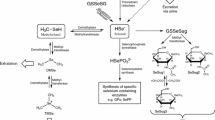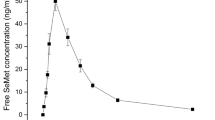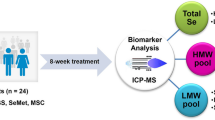Abstract
The aim of the present work was to compare and estimate absorption and biotransformation of selected selenium compounds by studying their fluxes across Caco-2 cells. Five different selenium compounds, selenomethionine (SeMet), Se-methylselenocysteine (MeSeCys), selenate, selenite, and methylseleninic acid (MeSeA), were applied to Caco-2 cells in a concentration of 10 μM, and fluxes in both directions were studied for 2 h. Fluxes of selenite and MeSeA in the presence of excess reduced glutathione (selenite + GSH and MeSeA + GSH) and flux of MeSeA in the presence of excess cysteine (MeSeA + Cys) were also studied. Selenium absorptive and exsorptive fluxes and accumulation in cell cytosol were analyzed by means of flow injection inductively coupled plasma mass spectrometry (ICP-MS). Absorptive flux of SeMet, MeSeCys, and selenate showed values correlating to complete in vivo absorption, while selenite and MeSeA fluxes correlated to poor in vivo absorption. Speciation analysis of cell lysate and donor and receptor solutions by LC-ICP-MS showed limited transformation of all selenium compounds. Extensive transformation as well as significantly increased absorptive flux was observed when co-administering selenite with glutathione compared to administering selenite alone. These observations are possibly due to formation of selenodiglutathione (GS-Se-SG) which may be absorbed differently than selenite. Concomitant application of GSH or cysteine with MeSeA resulted in extensive transformation of MeSeA, including volatile species, whereas no significant increases in fluxes were observed. In summary, the absorption of selenite selenate and the selenoamino acids is considered complete under physiological conditions, but the absorption mechanisms and metabolism of the compounds are different.







Similar content being viewed by others
References
Gladyshev V, Hatfiels D (1999) Selenocysteine-containing proteins in mammals. J Biomed Sci 6:151–160
Behne D, Weiss-Nowak C, Kalcklösch M, Westphal C, Gessner H, Kyriakopoulos A (1995) Studies on the distribution and characteristics of new mammalian selenium-containing proteins. Analyst 120:823–825
Thomson CD (2004) Assessment of requirements for selenium and adequacy of selenium status: a review. J Clin Nutr 58:391–402
Ashton K, Hooper L, Harvey LJ, Hurst R, Ccasgrain A, Fairweather-Tait S (2009) Methods of assessment of selenium status in humans: a systematic review (1–5). Am J Clin Nutr 89(suppl):2025S–2039S
Whanger PD (2004) Review article. Selenium and its relationship to cancer: an update. Br J Nutr 91:11–28
Behne D, Alber D, Kyriakopoulos A (2009) Effects of long-term selenium yeast supplementation on selenium status studied in the rat. J Trace Elem Med Biol 23:258–264
Schrauzer GN (2006) Selenium yeast: composition, quality, analysis, and safety. Pure Appl Chem 78:105–109
Schrauzer GN, Surai PF (2009) Selenium in human and animal nutrition: resolved and unresolved issues. Crit Rev Biotechnol 29:2–9
Gammelgaard B, Jackson M, Gabel-Jensen C (2011) Surveying selenium speciation from soil to cell—forms and transformations. Anal Bioanal Chem 399:1743–1763
Dumont E, Vanhaecke F, Cornelis R (2006) Selenium speciation from food source to metabolites: a critical review. Anal Bioanal Chem 385:1304–1323
Spencer RP (1962) Intestinal transport of selenium-75 selenomethionine. Science 136:155–156
Andersen O, Nielsen JB, Sørensen JA, Scherrebeck L (1994) Experimental localization of intestinal uptake sites for metals (Cd, Hg, Zn, Se) in vivo in mice. Environ Health Perspect 102:199–206
Hidalgo IJ, Raub TJ, Borchardt RT (1989) Characterization of the human-colon carcinoma cell-line (Caco-2) as a model system for intestinal epithelial permeability. Gastroenterology 96:736–749
Artursson P, Karlsson J (1991) Correlation between oral-drug absorption in humans and apparent drug permeability coefficients in human intestinal epithelial (Caco-2) cells. Biochem Biophys Res Comm 175:880–885
Leblondel G, Mauras Y, Cailleux A, Allain P (2001) Transport measurements across caco-2 monolayers of different organic and inorganic selenium. Biol Trace Elem Res 83:191–206
Zeng HW, Botnen JH, Johnson LK (2008) A selenium-deficient Caco-2 cell model for assessing differential incorporation of chemical or food selenium into glutathione peroxidase. Biol Trace Elem Res 123:98–108
Nickel A, Kottra G, Schmidt G, Danier J, Hofmann T, Daniel H (2009) Characteristics of transport of selenoamino acids by epithelial amino acid transporters. Chem-Biol Interact 177:234–241
Ballatori N, Krance SM, Marchan R, Hammond CL (2009) Plasma membrane glutathione transporters and their roles in cell physiology and pathophysiology. Mol Aspects Med 30:13–28
Siegers CP, Böse-Younes H, Thies E, Hoppenkamps R, Younes M (1984) Glutathione and GSH-dependent enzymes in the tumorous and nontumorous mucosa of the human colon and rectum. J Cancer Res Clin Onc 107:238–241
Keppler D (1999) Export pumps for glutathione S-conjugates. Free Radical Biol Med 27:985–991
Gabel-Jensen C, Gammelgaard B, Bendahl L, Stürup S, Jøns O (2006) Separation and identification of selenotrisulfides in epithelial cell homogenates by LC-ICP-MS and LC-ESI-MS after incubation with selenite. Anal Bioanal Chem 384:697–702
Gabel-Jensen C, Lunoe K, Madsen KG, Cornett C, Bendix J, Stürup S et al (2008) Separation and identification of the selenium-sulfur amino acid S-(methylseleno)cysteine in intestinal epithelial cell homogenates by LC-ICP-MS and LC-ESI-MS after incubation with MeSeA. J Anal At Spectrom 23:727–732
Gabel-Jensen C, Odgaard J, Skonberg C, Badolo L, Gammelgaard B (2009) LC-ICP-MS and LC-ESI-(MS)n identification of Se-MeSeCys and SeMet as mtabolites of MeSeA in rat hepatocytes. J Anal At Spectrom 24:69–75
Lunoe K, Skov S, Gabel-Jensen C, Sturup S, Gammelgaard B (2010) A method for analysis of dimethyl selenide and dimethyl diselenide by LC-ICP-DRC-MS. Anal Bioanal Chem 398:3081–3086
The Internationl Transporter Consortium (2010) Membrane transporters in drug development. Nat Rev Drug Discov 9:215–236
Tsopelas FN, Ochsenkuhn-Petropoulou MT, Tsantili-Kakoulidou A, Ochsenkuhn KM (2005) Study of the lipophilicity of selenium species. Anal Bioanal Chem 381:420–426
Artursson P, Karlsson J (1991) Correlation between oral-drug absorption in humans and apparent drug permeability coefficients in human intestinal epithelial (Caco-2) cells. Biochem Bioph Res Co 175:880–885
Lunoe K, Gabel-Jensen C, Sturup S, Andresen L, Skov S, Gammelgaard B (2011) Investigation of the selenium metabolism in cancer cell lines. Metallomics 3:162–168
Ganther HE (1986) Pathways of selenium metabolism including respiratory excretory products. J Am Coll Tocicol 5:1–5
Gabel-Jensen C, Lunoe K, Gammelgaard B (2010) Formation of methylselenol, dimethylselenide and dimethyldiselenide in in vitro metabolism models determined by headspace GC-MS. Metallomics 2:167–173
Gabel-Jensen C, Bak S, Lauritsen F, Hansen H, Badolo L, Gammelgaard B (2009) In situ identification of dimethyldiselenide in hepatocytes treate with methylseleninic acid by membrane inlet mass spectrometry. J Anal At Spectrom 24:949–952
Infante H, Joel SP, Warburton E, Hopley C, Hearn R, Jüliger S (2007) Investigation of the selenium species distribution in human B-cell lymphoma line by HPLC- and GC-ICP-MS in combination with HPLC-ESIMS/MS and GC-TOFMS after incubation with methylseleninic acid. J Anal At Spectrom 22:888–896
Acknowledgment
This project was supported by a grant (271-07-0302) from the Danish Research Council.
Author information
Authors and Affiliations
Corresponding author
Rights and permissions
About this article
Cite this article
Gammelgaard, B., Rasmussen, L.H., Gabel-Jensen, C. et al. Estimating Intestinal Absorption of Inorganic and Organic Selenium Compounds by in Vitro Flux and Biotransformation Studies in Caco-2 Cells and ICP-MS Detection. Biol Trace Elem Res 145, 248–256 (2012). https://doi.org/10.1007/s12011-011-9174-y
Received:
Accepted:
Published:
Issue Date:
DOI: https://doi.org/10.1007/s12011-011-9174-y




